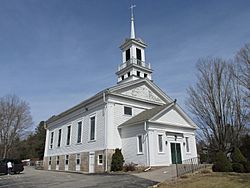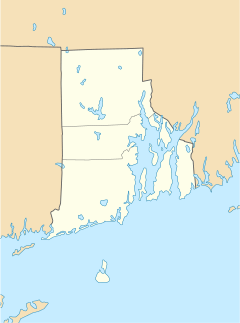Hope Valley, Rhode Island facts for kids
Quick facts for kids
Hope Valley, Rhode Island
|
|
|---|---|

First Baptist Church
|
|
| Country | United States |
| State | Rhode Island |
| County | Washington |
| Area | |
| • Total | 3.53 sq mi (9.13 km2) |
| • Land | 3.32 sq mi (8.60 km2) |
| • Water | 0.20 sq mi (0.53 km2) |
| Elevation | 85 ft (26 m) |
| Population
(2020)
|
|
| • Total | 1,870 |
| • Density | 562.91/sq mi (217.37/km2) |
| Time zone | UTC−5 (Eastern (EST)) |
| • Summer (DST) | UTC−4 (EDT) |
| ZIP Code |
02832
|
| Area code(s) | 401 |
| FIPS code | 44-34660 |
| GNIS feature ID | 1217875 |
|
Hope Valley Historic District
|
|
| Lua error in Module:Location_map at line 420: attempt to index field 'wikibase' (a nil value). | |
| Location | Main St., Hopkinton, Rhode Island |
|---|---|
| Built | 1770 |
| NRHP reference No. | 04000654 |
| Added to NRHP | July 3, 2004 |
Hope Valley is a village and a special kind of community called a census-designated place (CDP) in the town of Hopkinton, Rhode Island, United States. In 2010, about 1,612 people lived here. Hope Valley is the biggest village in Hopkinton. It is also the main place for shops and businesses in the town. Even though the village is in Hopkinton, its ZIP Code (02832) also covers parts of the nearby town of Richmond.
The middle part of the village was recognized as the Hope Valley Historic District in 2004. This means it has many old buildings that are important to history. The historic area is about 183 acres big. It includes 134 buildings and three other structures that add to its historical value.
Contents
History of Hope Valley
Early Settlement and Mills
The first European-American settlers arrived in Hope Valley around 1770. A man named Hezekiah Carpenter was one of the first. He built a dam on the Wood River. This dam helped power several small mills. Because of him, the settlement was first known as Carpenter's Mills.
Around 1818, a tannery was built in the area. A tannery is a place where animal skins are turned into leather. The textile industry came to Hope Valley in 1824. Gardner Nichols and Russell Thayer bought the mills. They started using them to prepare wool and make cloth. They also made machines for textiles.
Growth and Merging Villages
The village of Locustville used to be a separate place. It grew up along a stream called Brushy Brook. A dam and mill were built there in 1820. Now, Locustville is part of Hope Valley. In the late 1800s, the Nichols and Langworthy Company took over the Locustville mill. This company had been running the Hope Valley mills since 1835.
How Hope Valley Got Its Name
There are different stories about how Hope Valley got its name. The word "Hope" is part of Rhode Island's official motto. It is used in many place names across the state. The phrase is also on the Rhode Island State Seal with an anchor. This is because Roger Williams was inspired by a Bible verse. It says "hope is the anchor of the soul."
In 2008, a local historian shared a story. They said Gardner Nichols renamed the village from Carpenter's Mills to Hope Valley. This was because "all of his hopes were centered" in the village. This story can also be found in the book History of the State of Rhode Island.
Geography of Hope Valley
Hope Valley is located at these coordinates: 41°30′27″N 71°42′59″W / 41.50750°N 71.71639°W. This helps pinpoint its exact spot on a map.
The United States Census Bureau says that Hope Valley covers a total area of about 9.1 square kilometers (3.5 square miles). Most of this area, about 8.5 square kilometers (3.3 square miles), is land. The remaining 0.5 square kilometers (0.2 square miles), which is about 5.43%, is water.
Population and People
| Historical population | |||
|---|---|---|---|
| Census | Pop. | %± | |
| 2020 | 1,870 | — | |
| U.S. Decennial Census | |||
Hope Valley Population in 2020
The 2020 United States census counted 1,870 people living in Hope Valley. There were 723 households and 568 families. This means there were about 563 people per square mile. There were 787 housing units in total.
Most of the people in Hope Valley were white, making up about 91.6% of the population. A small number were black or African-American (0.64%). There were also Native American (0.43%) and Asian (0.86%) residents. About 1.5% were from other races, and nearly 5% were from two or more races. About 2.57% of the population identified as Hispanic or Latino.
About 33.1% of households had children under 18 years old. More than half (53.3%) were married couples living together. About 21.0% of households had a female head with no spouse. Around 25.4% of households were single individuals. About 11.3% of households had someone living alone who was 65 years or older. The average household had 2.8 people. The average family had 2.9 people.
About 21.9% of the population was under 18 years old. About 16.1% were 65 years or older. The average age in Hope Valley was 44.0 years. For every 100 females, there were about 93 males.
Notable People from Hope Valley
Hope Valley has been home to some interesting people.
- Prudence Crandall was born in this area in 1803. She started an important school for African-American girls. There is a special stone marker in the village to remember her.
- Hope Valley is also the hometown of country music singer Billy Gilman.
See also
 In Spanish: Hope Valley para niños
In Spanish: Hope Valley para niños


